
notte
🔥 Reliable Browser AI agents (YC S25)
Stars: 1624
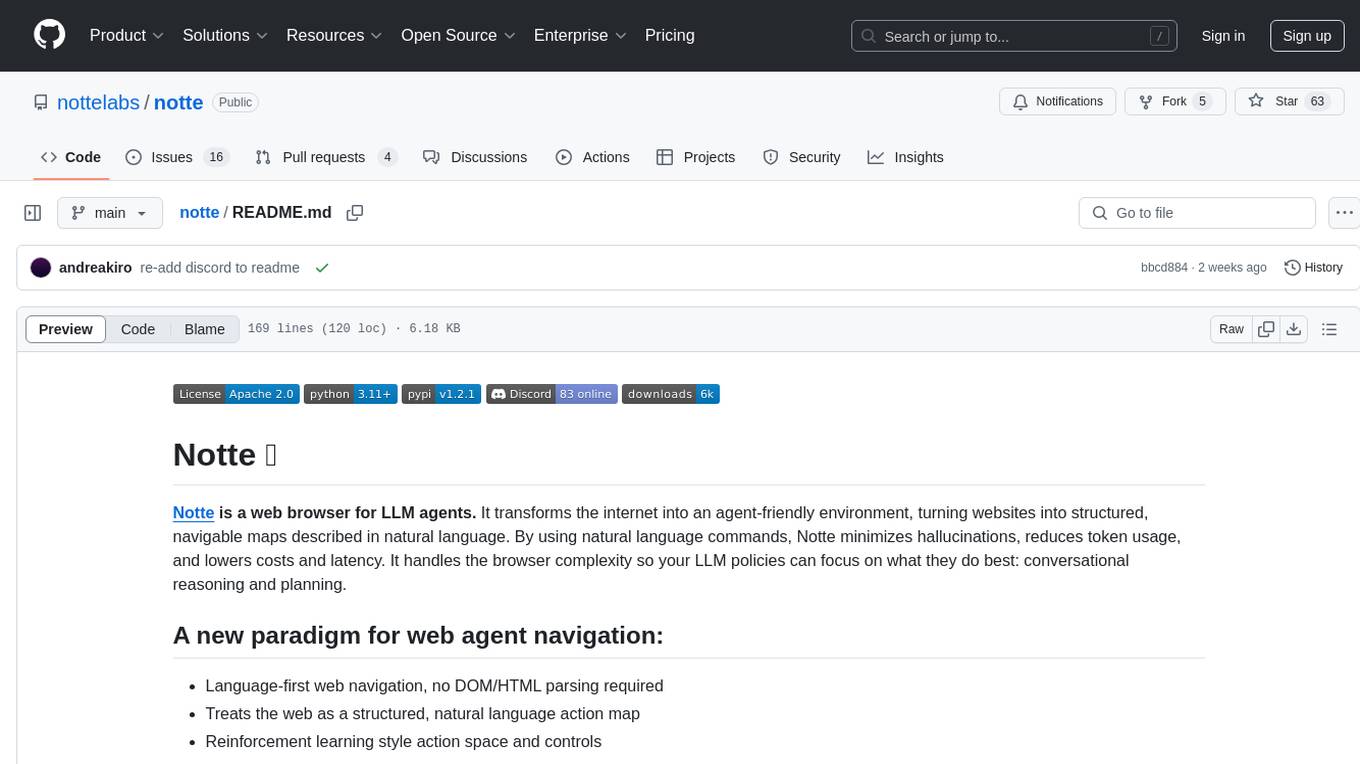
Notte is a web browser designed specifically for LLM agents, providing a language-first web navigation experience without the need for DOM/HTML parsing. It transforms websites into structured, navigable maps described in natural language, enabling users to interact with the web using natural language commands. By simplifying browser complexity, Notte allows LLM policies to focus on conversational reasoning and planning, reducing token usage, costs, and latency. The tool supports various language model providers and offers a reinforcement learning style action space and controls for full navigation control.
README:
The web agent framework built for speed, cost-efficiency, scale, and reliability
→ Read more at: open-operator-evals • X • LinkedIn • Landing • Console
Notte provides all the essential tools for building and deploying AI agents that interact seamlessly with the web. Our full-stack framework combines AI agents with traditional scripting for maximum efficiency - letting you script deterministic parts and use AI only when needed, cutting costs by 50%+ while improving reliability. We allow you to develop, deploy, and scale your own agents and web automations, all with a single API. Read more in our documentation here 🔥
Opensource Core:
- Run web agents → Give AI agents natural language tasks to complete on websites
- Structured Output → Get data in your exact format with Pydantic models
- Site Interactions → Observe website states, scrape data and execute actions using Playwright compatible primitives and natural language commands
API service (Recommended)
- Stealth Browser Sessions → Browser instances with built-in CAPTCHA solving, proxies, and anti-detection
- Hybrid Workflows → Combine scripting and AI agents to reduce costs and improve reliability
- Secrets Vaults → Enterprise-grade credential management to store emails, passwords, MFA tokens, SSO, etc.
- Digital Personas → Create digital identities with unique emails, phones, and automated 2FA for account creation workflows
pip install notte
patchright install --with-deps chromium
Use the following script to spinup an agent using opensource features (you'll need your own LLM API keys):
import notte
from dotenv import load_dotenv
load_dotenv()
with notte.Session(headless=False) as session:
agent = notte.Agent(session=session, reasoning_model='gemini/gemini-2.5-flash', max_steps=30)
response = agent.run(task="doom scroll cat memes on google images")We also provide an effortless API that hosts the browser sessions for you - and provide plenty of premium features. To run the agent you'll need to first sign up on the Notte Console and create a free Notte API key 🔑
from notte_sdk import NotteClient
import os
client = NotteClient(api_key=os.getenv("NOTTE_API_KEY"))
with client.Session(headless=False) as session:
agent = client.Agent(session=session, reasoning_model='gemini/gemini-2.5-flash', max_steps=30)
response = agent.run(task="doom scroll cat memes on google images")Our setup allows you to experiment locally, then drop-in replace the import and prefix notte objects with cli to switch to SDK and get hosted browser sessions plus access to premium features!
| Rank | Provider | Agent Self-Report | LLM Evaluation | Time per Task | Task Reliability |
|---|---|---|---|---|---|
| 🏆 | Notte | 86.2% | 79.0% | 47s | 96.6% |
| 2️⃣ | Browser-Use | 77.3% | 60.2% | 113s | 83.3% |
| 3️⃣ | Convergence | 38.4% | 31.4% | 83s | 50% |
Read the full story here: https://github.com/nottelabs/open-operator-evals
Structured output is a feature of the agent's run function that allows you to specify a Pydantic model as the response_format parameter. The agent will return data in the specified structure.
from notte_sdk import NotteClient
from pydantic import BaseModel
class HackerNewsPost(BaseModel):
title: str
url: str
points: int
author: str
comments_count: int
class TopPosts(BaseModel):
posts: list[HackerNewsPost]
client = NotteClient()
with client.Session(headless=False, browser_type="firefox") as session:
agent = client.Agent(session=session, reasoning_model='gemini/gemini-2.5-flash', max_steps=15)
response = agent.run(
task="Go to Hacker News (news.ycombinator.com) and extract the top 5 posts with their titles, URLs, points, authors, and comment counts.",
response_format=TopPosts,
)
print(response.answer)Vaults are tools you can attach to your Agent instance to securely store and manage credentials. The agent automatically uses these credentials when needed.
from notte_sdk import NotteClient
client = NotteClient()
with client.Vault() as vault, client.Session(headless=False) as session:
vault.add_credentials(
url="https://x.com",
username="your-email",
password="your-password",
)
agent = client.Agent(session=session, vault=vault, max_steps=10)
response = agent.run(
task="go to twitter; login and go to my messages",
)
print(response.answer)Personas are tools you can attach to your Agent instance to provide digital identities with unique email addresses, phone numbers, and automated 2FA handling.
from notte_sdk import NotteClient
client = NotteClient()
with client.Persona(create_phone_number=False) as persona:
with client.Session(browser_type="firefox", headless=False) as session:
agent = client.Agent(session=session, persona=persona, max_steps=15)
response = agent.run(
task="Open the Google form and RSVP yes with your name",
url="https://forms.google.com/your-form-url",
)
print(response.answer)Stealth features include automatic CAPTCHA solving and proxy configuration to enhance automation reliability and anonymity.
from notte_sdk import NotteClient
from notte_sdk.types import NotteProxy, ExternalProxy
client = NotteClient()
# Built-in proxies with CAPTCHA solving
with client.Session(
solve_captchas=True,
proxies=True, # US-based proxy
browser_type="firefox",
headless=False
) as session:
agent = client.Agent(session=session, max_steps=5)
response = agent.run(
task="Try to solve the CAPTCHA using internal tools",
url="https://www.google.com/recaptcha/api2/demo"
)
# Custom proxy configuration
proxy_settings = ExternalProxy(
server="http://your-proxy-server:port",
username="your-username",
password="your-password",
)
with client.Session(proxies=[proxy_settings]) as session:
agent = client.Agent(session=session, max_steps=5)
response = agent.run(task="Navigate to a website")File Storage allows you to upload files to a session and download files that agents retrieve during their work. Files are session-scoped and persist beyond the session lifecycle.
from notte_sdk import NotteClient
client = NotteClient()
storage = client.FileStorage()
# Upload files before agent execution
storage.upload("/path/to/document.pdf")
# Create session with storage attached
with client.Session(storage=storage) as session:
agent = client.Agent(session=session, max_steps=5)
response = agent.run(
task="Upload the PDF document to the website and download the cat picture",
url="https://example.com/upload"
)
# Download files that the agent downloaded
downloaded_files = storage.list(type="downloads")
for file_name in downloaded_files:
storage.download(file_name=file_name, local_dir="./results")Cookies provide a flexible way to authenticate your sessions. While we recommend using the secure vault for credential management, cookies offer an alternative approach for certain use cases.
from notte_sdk import NotteClient
import json
client = NotteClient()
# Upload cookies for authentication
cookies = [
{
"name": "sb-db-auth-token",
"value": "base64-cookie-value",
"domain": "github.com",
"path": "/",
"expires": 9778363203.913704,
"httpOnly": False,
"secure": False,
"sameSite": "Lax"
}
]
with client.Session() as session:
session.set_cookies(cookies=cookies) # or cookie_file="path/to/cookies.json"
agent = client.Agent(session=session, max_steps=5)
response = agent.run(
task="go to nottelabs/notte get repo info",
)
# Get cookies from the session
cookies_resp = session.get_cookies()
with open("cookies.json", "w") as f:
json.dump(cookies_resp, f)You can plug in any browser session provider you want and use our agent on top. Use external headless browser providers via CDP to benefit from Notte's agentic capabilities with any CDP-compatible browser.
from notte_sdk import NotteClient
client = NotteClient()
cdp_url = "wss://your-external-cdp-url"
with client.Session(cdp_url=cdp_url) as session:
agent = client.Agent(session=session)
response = agent.run(task="extract pricing plans from https://www.notte.cc/")Notte's close compatibility with Playwright allows you to mix web automation primitives with agents for specific parts that require reasoning and adaptability. This hybrid approach cuts LLM costs and is much faster by using scripting for deterministic parts and agents only when needed.
from notte_sdk import NotteClient
client = NotteClient()
with client.Session(headless=False, perception_type="fast") as session:
# Script execution for deterministic navigation
session.execute({"type": "goto", "url": "https://www.quince.com/women/organic-stretch-cotton-chino-short"})
session.observe()
# Agent for reasoning-based selection
agent = client.Agent(session=session)
agent.run(task="just select the ivory color in size 6 option")
# Script execution for deterministic actions
session.execute({"type": "click", "selector": "internal:role=button[name=\"ADD TO CART\"i]"})
session.execute({"type": "click", "selector": "internal:role=button[name=\"CHECKOUT\"i]"})Workflows are a powerful way to combine scripting and agents to reduce costs and improve reliability. However, deterministic parts of the workflow can still fail. To gracefully handle these failures with agents, you can use the AgentFallback class:
import notte
with notte.Session() as session:
_ = session.execute({"type": "goto", "value": "https://shop.notte.cc/"})
_ = session.observe()
with notte.AgentFallback(session, "Go to cart"):
# Force execution failure -> trigger an agent fallback to gracefully fix the issue
res = session.execute(type="click", id="INVALID_ACTION_ID")For fast data extraction, we provide a dedicated scraping endpoint that automatically creates and manages sessions. You can pass custom instructions for structured outputs and enable stealth mode.
from notte_sdk import NotteClient
from pydantic import BaseModel
client = NotteClient()
# Simple scraping
response = client.scrape(
url="https://notte.cc",
scrape_links=True,
only_main_content=True
)
# Structured scraping with custom instructions
class Article(BaseModel):
title: str
content: str
date: str
response = client.scrape(
url="https://example.com/blog",
response_format=Article,
instructions="Extract only the title, date and content of the articles"
)Or directly with cURL
curl -X POST 'https://api.notte.cc/scrape' \
-H 'Authorization: Bearer <NOTTE-API-KEY>' \
-H 'Content-Type: application/json' \
-d '{
"url": "https://notte.cc",
"only_main_content": false,
}'Search: We've built a cool demo of an LLM leveraging the scraping endpoint in an MCP server to make real-time search in an LLM chatbot - works like a charm! Available here: https://search.notte.cc/
This project is licensed under the Server Side Public License v1. See the LICENSE file for details.
If you use notte in your research or project, please cite:
@software{notte2025,
author = {Pinto, Andrea and Giordano, Lucas and {nottelabs-team}},
title = {Notte: Software suite for internet-native agentic systems},
url = {https://github.com/nottelabs/notte},
year = {2025},
publisher = {GitHub},
license = {SSPL-1.0}
version = {1.4.4},
}Copyright © 2025 Notte Labs, Inc.
For Tasks:
Click tags to check more tools for each tasksFor Jobs:
Alternative AI tools for notte
Similar Open Source Tools

notte
Notte is a web browser designed specifically for LLM agents, providing a language-first web navigation experience without the need for DOM/HTML parsing. It transforms websites into structured, navigable maps described in natural language, enabling users to interact with the web using natural language commands. By simplifying browser complexity, Notte allows LLM policies to focus on conversational reasoning and planning, reducing token usage, costs, and latency. The tool supports various language model providers and offers a reinforcement learning style action space and controls for full navigation control.
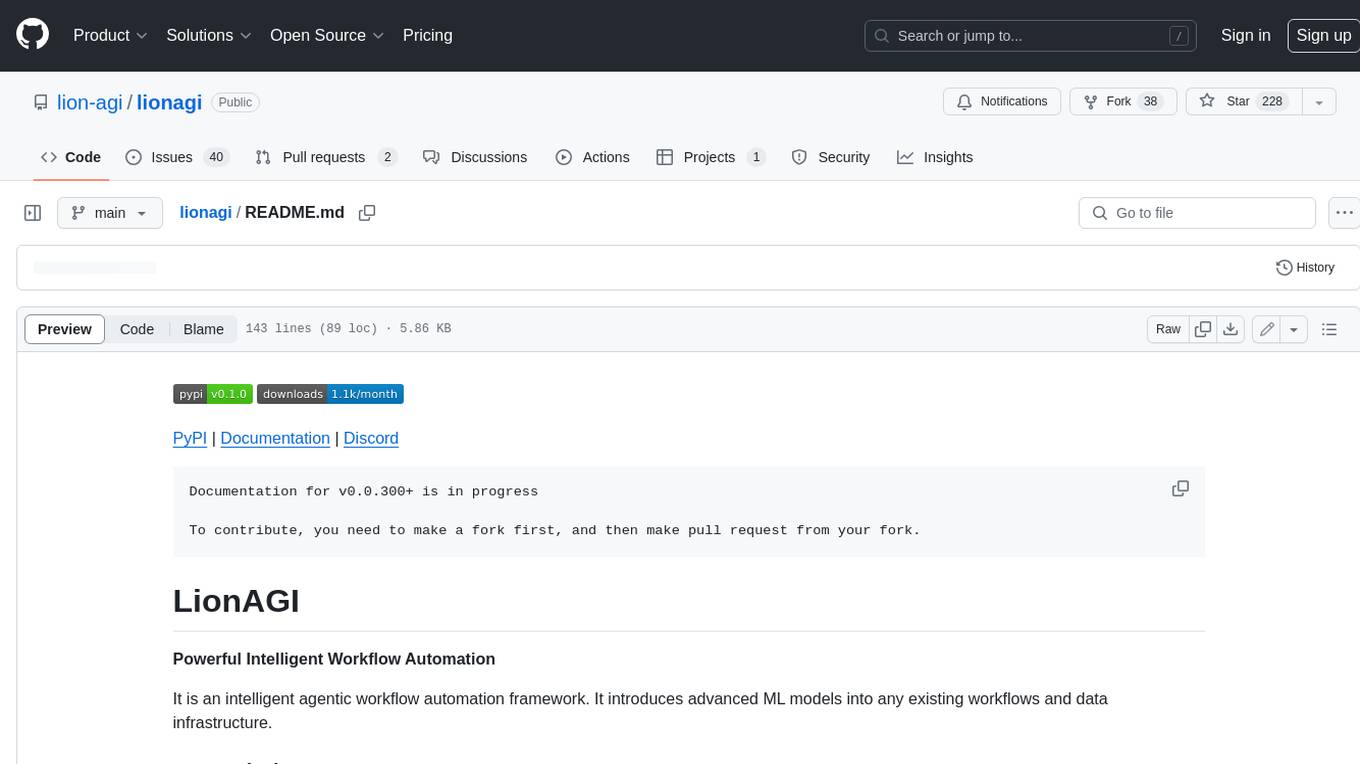
lionagi
LionAGI is a powerful intelligent workflow automation framework that introduces advanced ML models into any existing workflows and data infrastructure. It can interact with almost any model, run interactions in parallel for most models, produce structured pydantic outputs with flexible usage, automate workflow via graph based agents, use advanced prompting techniques, and more. LionAGI aims to provide a centralized agent-managed framework for "ML-powered tools coordination" and to dramatically lower the barrier of entries for creating use-case/domain specific tools. It is designed to be asynchronous only and requires Python 3.10 or higher.

litdata
LitData is a tool designed for blazingly fast, distributed streaming of training data from any cloud storage. It allows users to transform and optimize data in cloud storage environments efficiently and intuitively, supporting various data types like images, text, video, audio, geo-spatial, and multimodal data. LitData integrates smoothly with frameworks such as LitGPT and PyTorch, enabling seamless streaming of data to multiple machines. Key features include multi-GPU/multi-node support, easy data mixing, pause & resume functionality, support for profiling, memory footprint reduction, cache size configuration, and on-prem optimizations. The tool also provides benchmarks for measuring streaming speed and conversion efficiency, along with runnable templates for different data types. LitData enables infinite cloud data processing by utilizing the Lightning.ai platform to scale data processing with optimized machines.
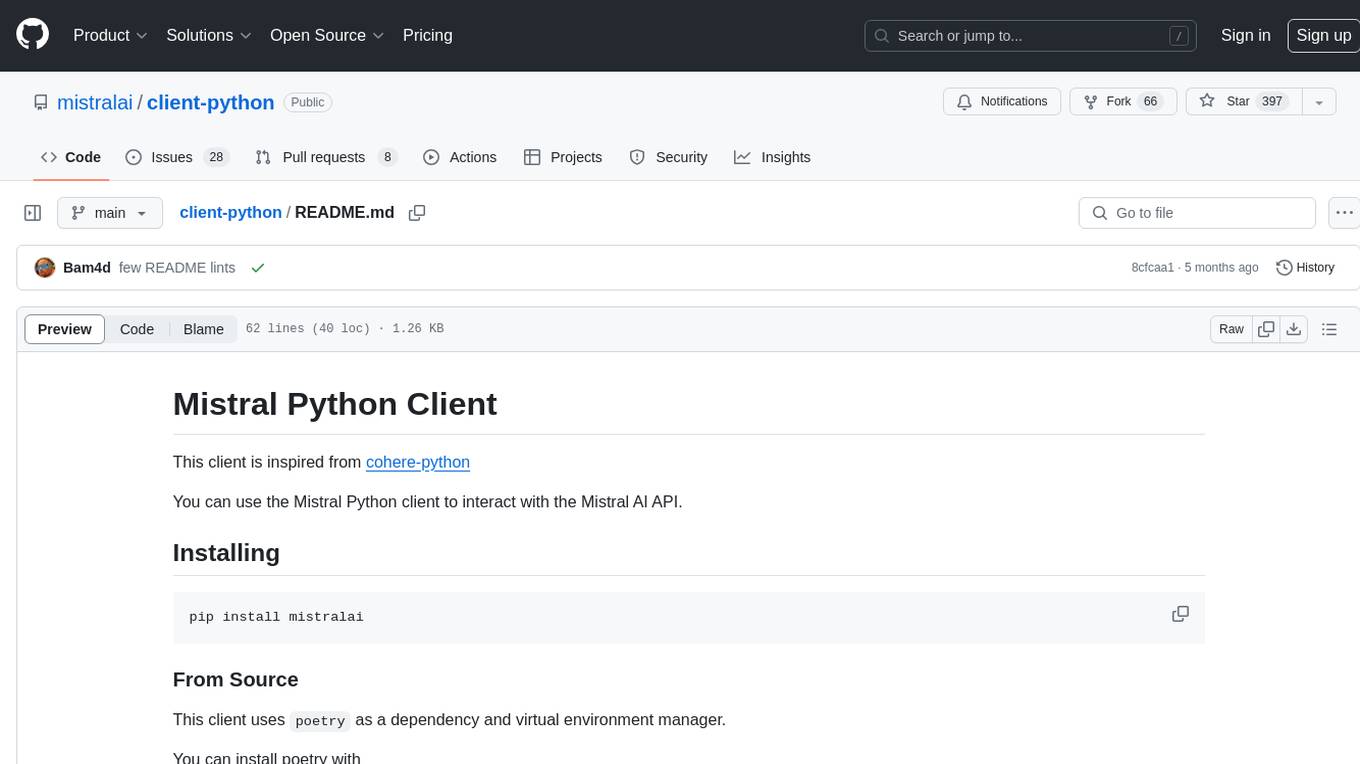
client-python
The Mistral Python Client is a tool inspired by cohere-python that allows users to interact with the Mistral AI API. It provides functionalities to access and utilize the AI capabilities offered by Mistral. Users can easily install the client using pip and manage dependencies using poetry. The client includes examples demonstrating how to use the API for various tasks, such as chat interactions. To get started, users need to obtain a Mistral API Key and set it as an environment variable. Overall, the Mistral Python Client simplifies the integration of Mistral AI services into Python applications.
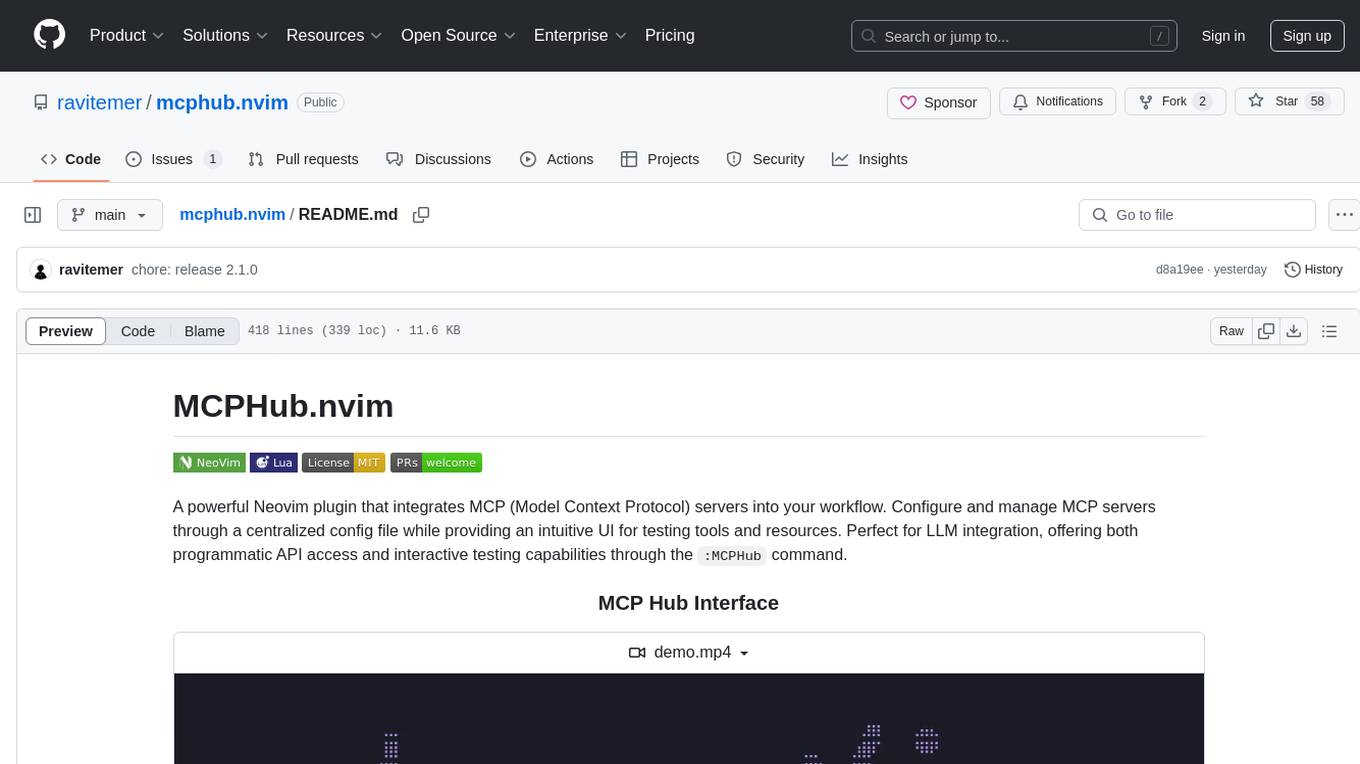
mcphub.nvim
MCPHub.nvim is a powerful Neovim plugin that integrates MCP (Model Context Protocol) servers into your workflow. It offers a centralized config file for managing servers and tools, with an intuitive UI for testing resources. Ideal for LLM integration, it provides programmatic API access and interactive testing through the `:MCPHub` command.

rl
TorchRL is an open-source Reinforcement Learning (RL) library for PyTorch. It provides pytorch and **python-first** , low and high level abstractions for RL that are intended to be **efficient** , **modular** , **documented** and properly **tested**. The code is aimed at supporting research in RL. Most of it is written in python in a highly modular way, such that researchers can easily swap components, transform them or write new ones with little effort.
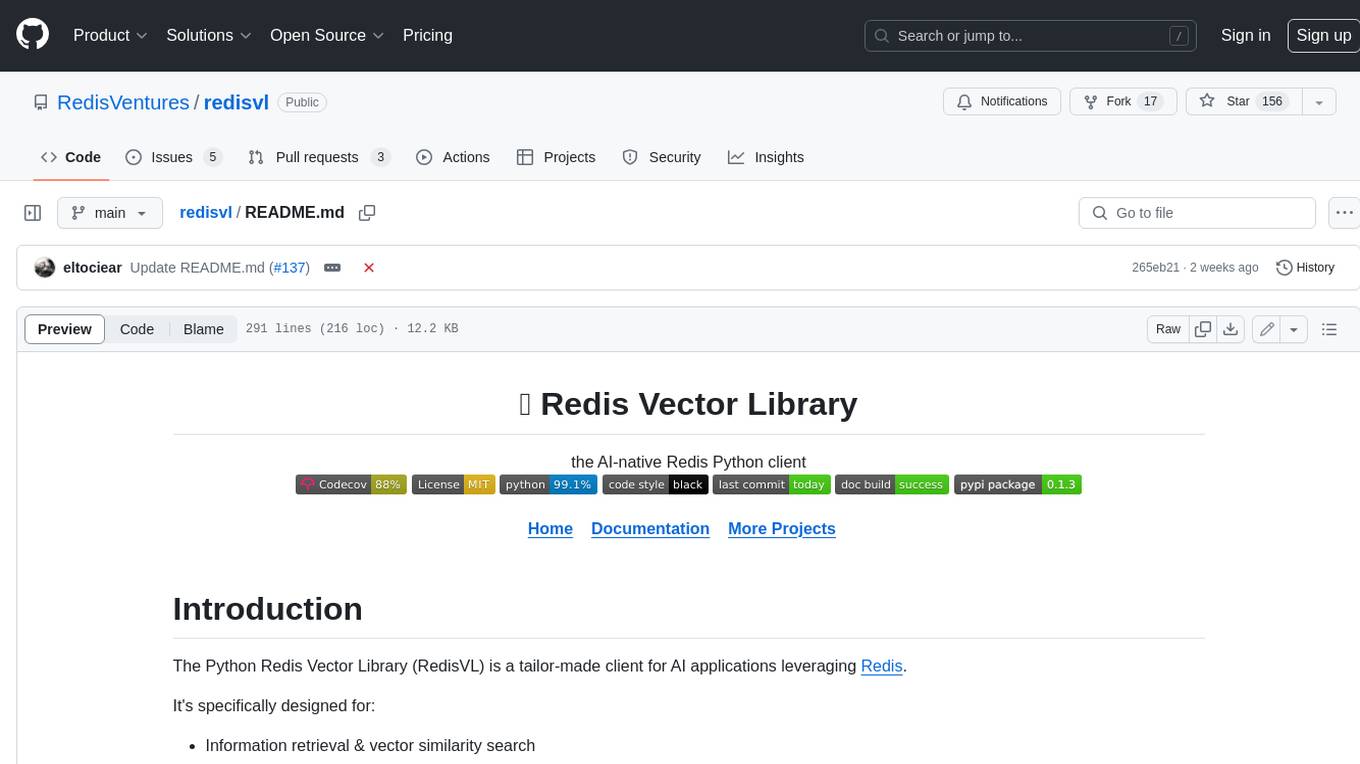
redisvl
Redis Vector Library (RedisVL) is a Python client library for building AI applications on top of Redis. It provides a high-level interface for managing vector indexes, performing vector search, and integrating with popular embedding models and providers. RedisVL is designed to make it easy for developers to build and deploy AI applications that leverage the speed, flexibility, and reliability of Redis.
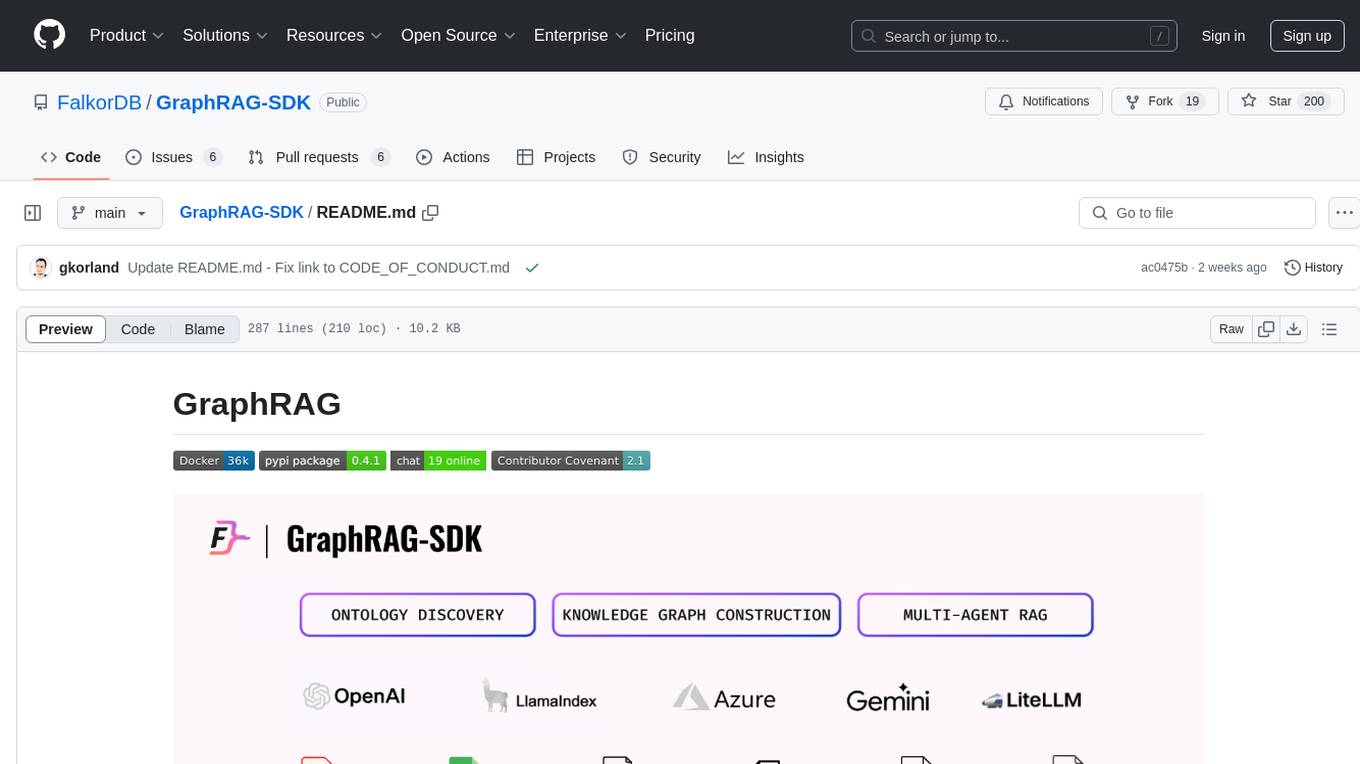
GraphRAG-SDK
Build fast and accurate GenAI applications with GraphRAG SDK, a specialized toolkit for building Graph Retrieval-Augmented Generation (GraphRAG) systems. It integrates knowledge graphs, ontology management, and state-of-the-art LLMs to deliver accurate, efficient, and customizable RAG workflows. The SDK simplifies the development process by automating ontology creation, knowledge graph agent creation, and query handling, enabling users to interact and query their knowledge graphs effectively. It supports multi-agent systems and orchestrates agents specialized in different domains. The SDK is optimized for FalkorDB, ensuring high performance and scalability for large-scale applications. By leveraging knowledge graphs, it enables semantic relationships and ontology-driven queries that go beyond standard vector similarity, enhancing retrieval-augmented generation capabilities.
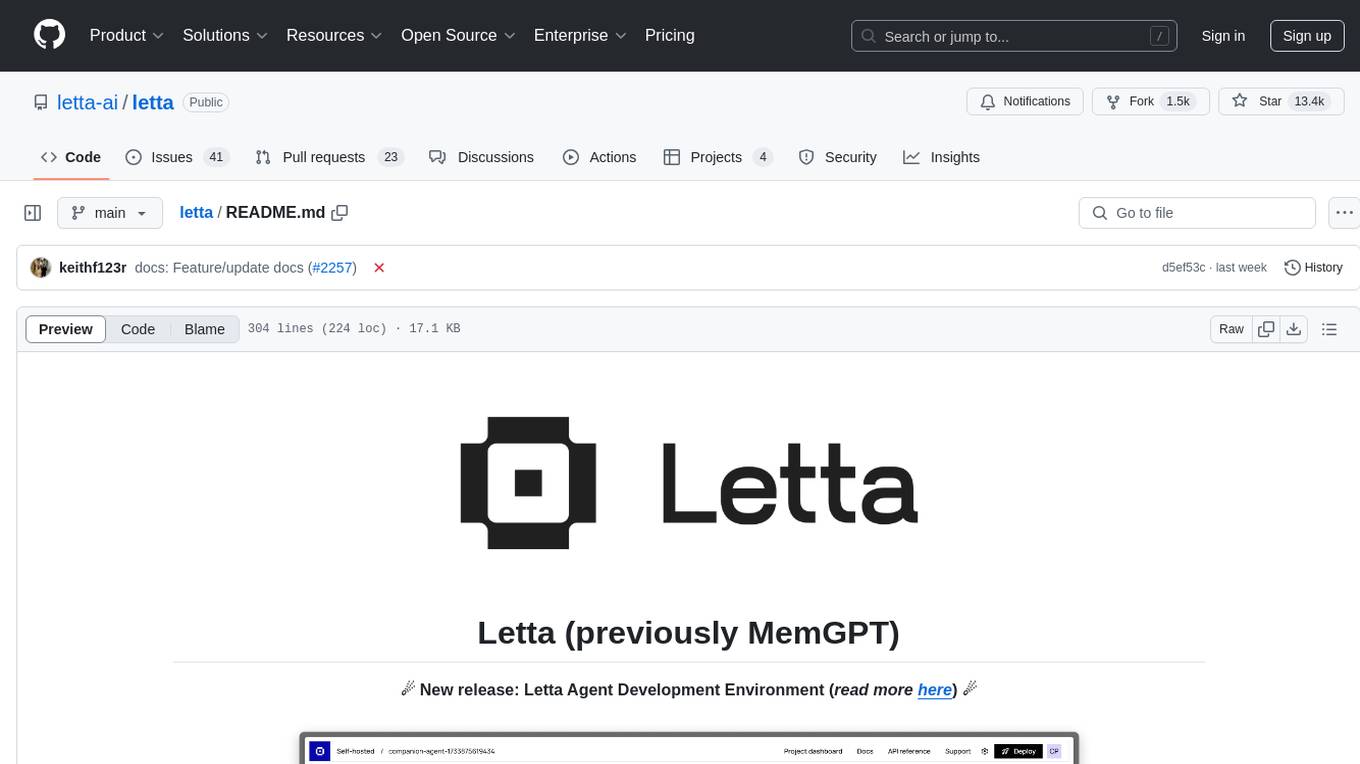
letta
Letta is an open source framework for building stateful LLM applications. It allows users to build stateful agents with advanced reasoning capabilities and transparent long-term memory. The framework is white box and model-agnostic, enabling users to connect to various LLM API backends. Letta provides a graphical interface, the Letta ADE, for creating, deploying, interacting, and observing with agents. Users can access Letta via REST API, Python, Typescript SDKs, and the ADE. Letta supports persistence by storing agent data in a database, with PostgreSQL recommended for data migrations. Users can install Letta using Docker or pip, with Docker defaulting to PostgreSQL and pip defaulting to SQLite. Letta also offers a CLI tool for interacting with agents. The project is open source and welcomes contributions from the community.
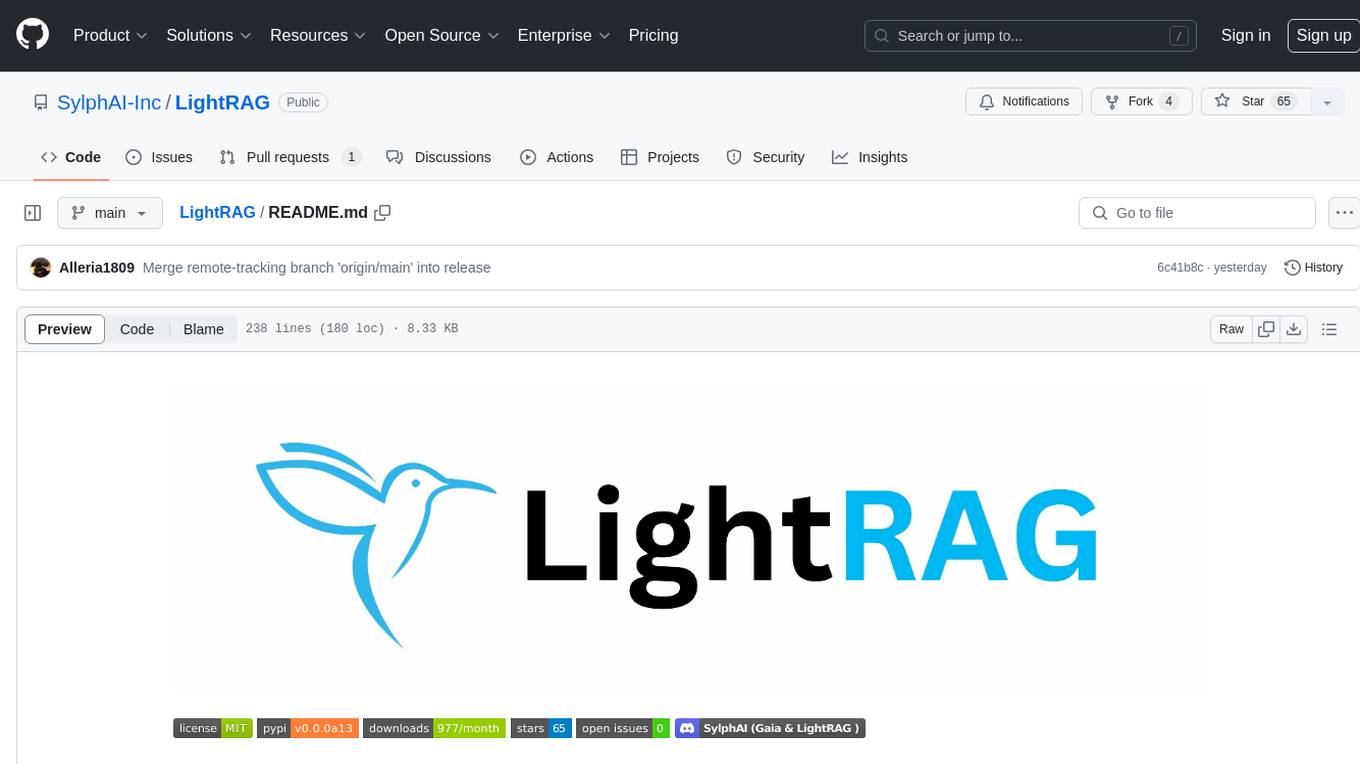
LightRAG
LightRAG is a PyTorch library designed for building and optimizing Retriever-Agent-Generator (RAG) pipelines. It follows principles of simplicity, quality, and optimization, offering developers maximum customizability with minimal abstraction. The library includes components for model interaction, output parsing, and structured data generation. LightRAG facilitates tasks like providing explanations and examples for concepts through a question-answering pipeline.
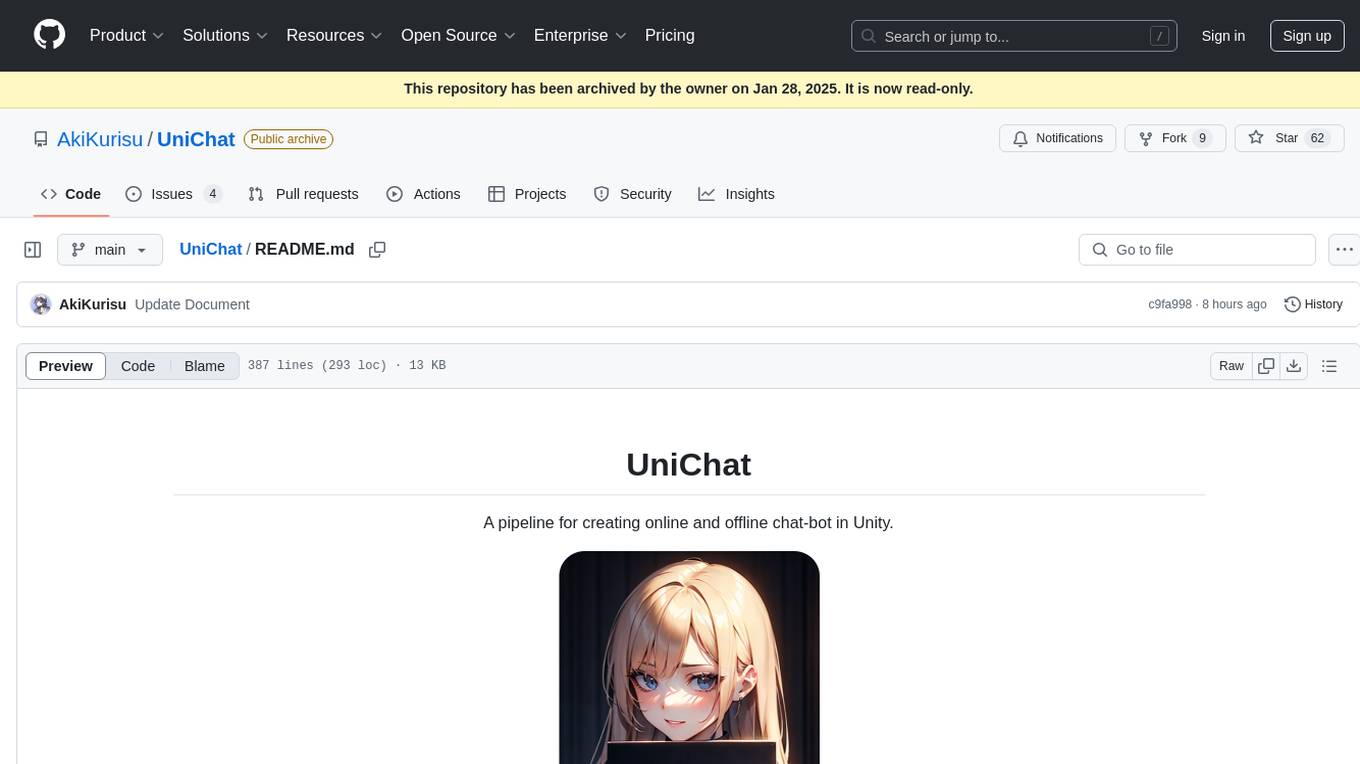
UniChat
UniChat is a pipeline tool for creating online and offline chat-bots in Unity. It leverages Unity.Sentis and text vector embedding technology to enable offline mode text content search based on vector databases. The tool includes a chain toolkit for embedding LLM and Agent in games, along with middleware components for Text to Speech, Speech to Text, and Sub-classifier functionalities. UniChat also offers a tool for invoking tools based on ReActAgent workflow, allowing users to create personalized chat scenarios and character cards. The tool provides a comprehensive solution for designing flexible conversations in games while maintaining developer's ideas.
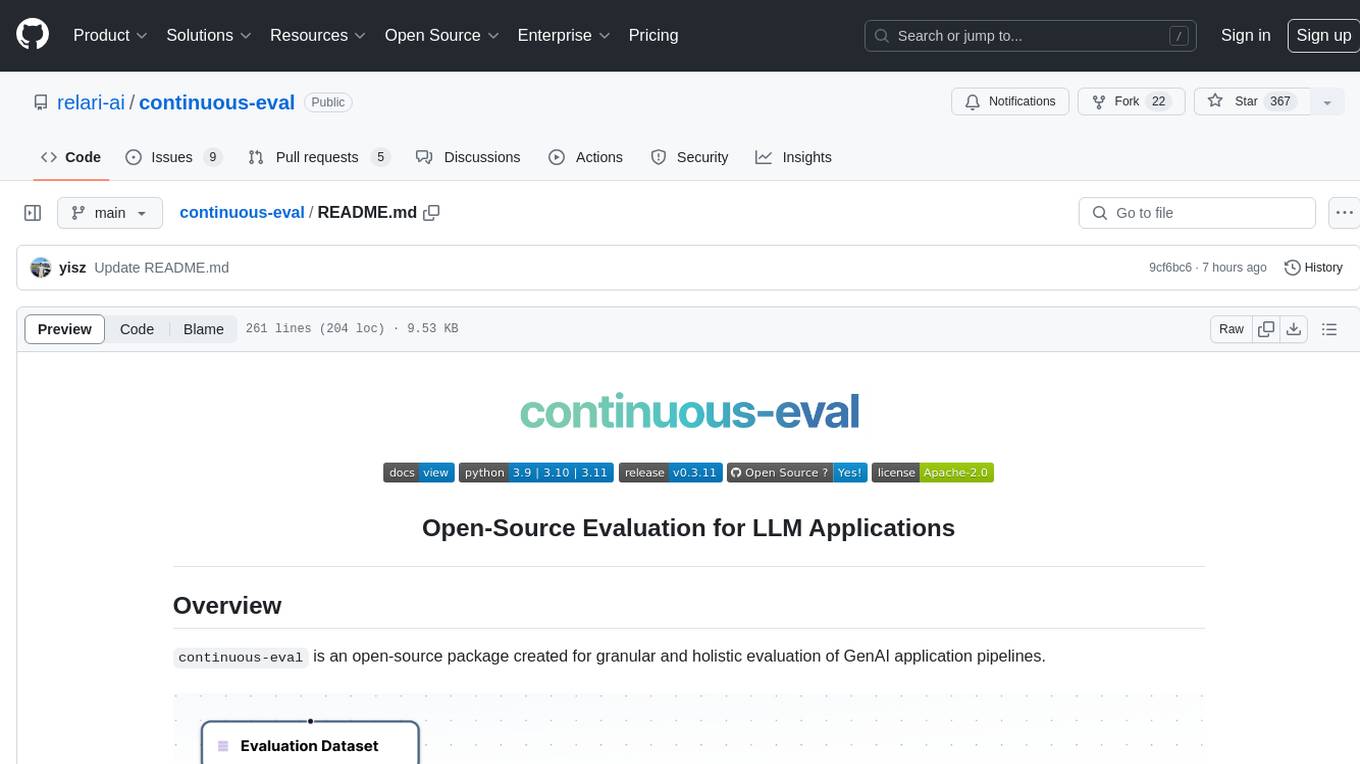
continuous-eval
Open-Source Evaluation for LLM Applications. `continuous-eval` is an open-source package created for granular and holistic evaluation of GenAI application pipelines. It offers modularized evaluation, a comprehensive metric library covering various LLM use cases, the ability to leverage user feedback in evaluation, and synthetic dataset generation for testing pipelines. Users can define their own metrics by extending the Metric class. The tool allows running evaluation on a pipeline defined with modules and corresponding metrics. Additionally, it provides synthetic data generation capabilities to create user interaction data for evaluation or training purposes.
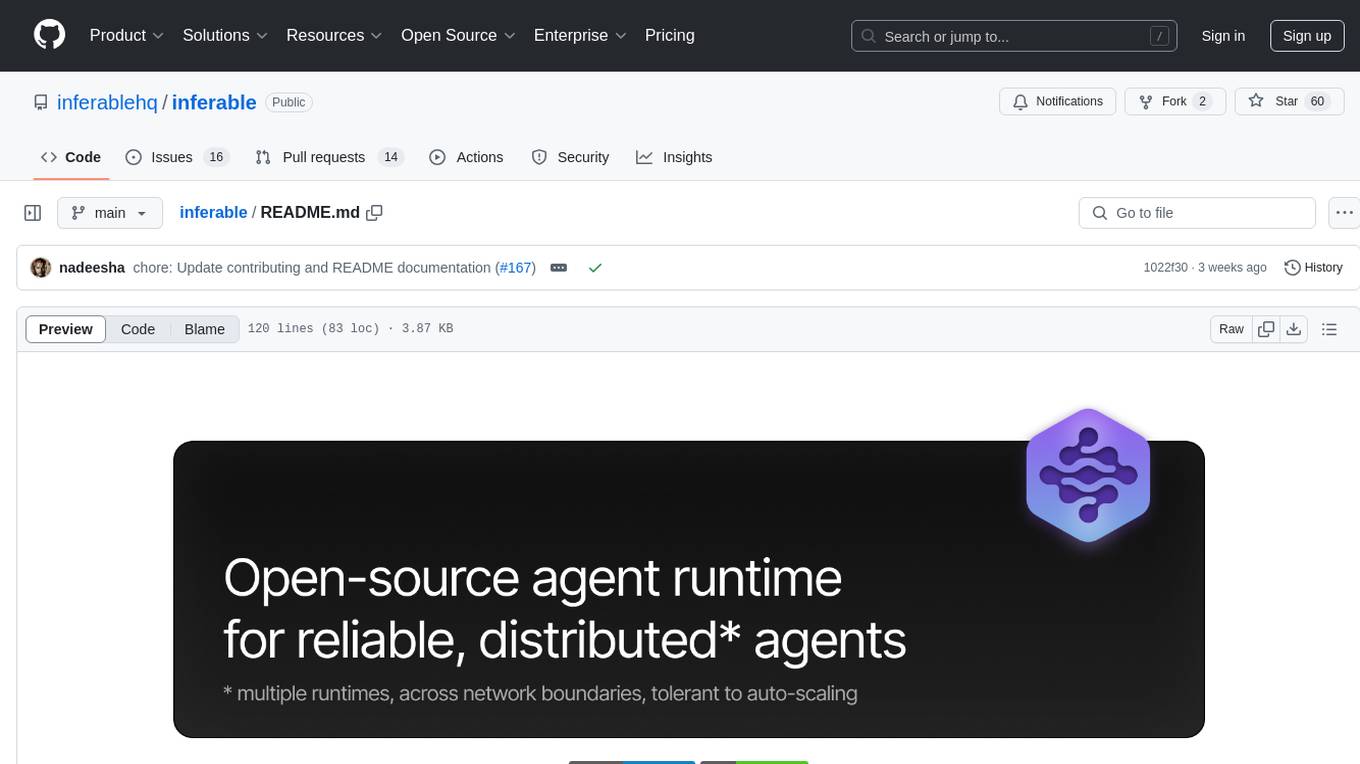
inferable
Inferable is an open source platform that helps users build reliable LLM-powered agentic automations at scale. It offers a managed agent runtime, durable tool calling, zero network configuration, multiple language support, and is fully open source under the MIT license. Users can define functions, register them with Inferable, and create runs that utilize these functions to automate tasks. The platform supports Node.js/TypeScript, Go, .NET, and React, and provides SDKs, core services, and bootstrap templates for various languages.
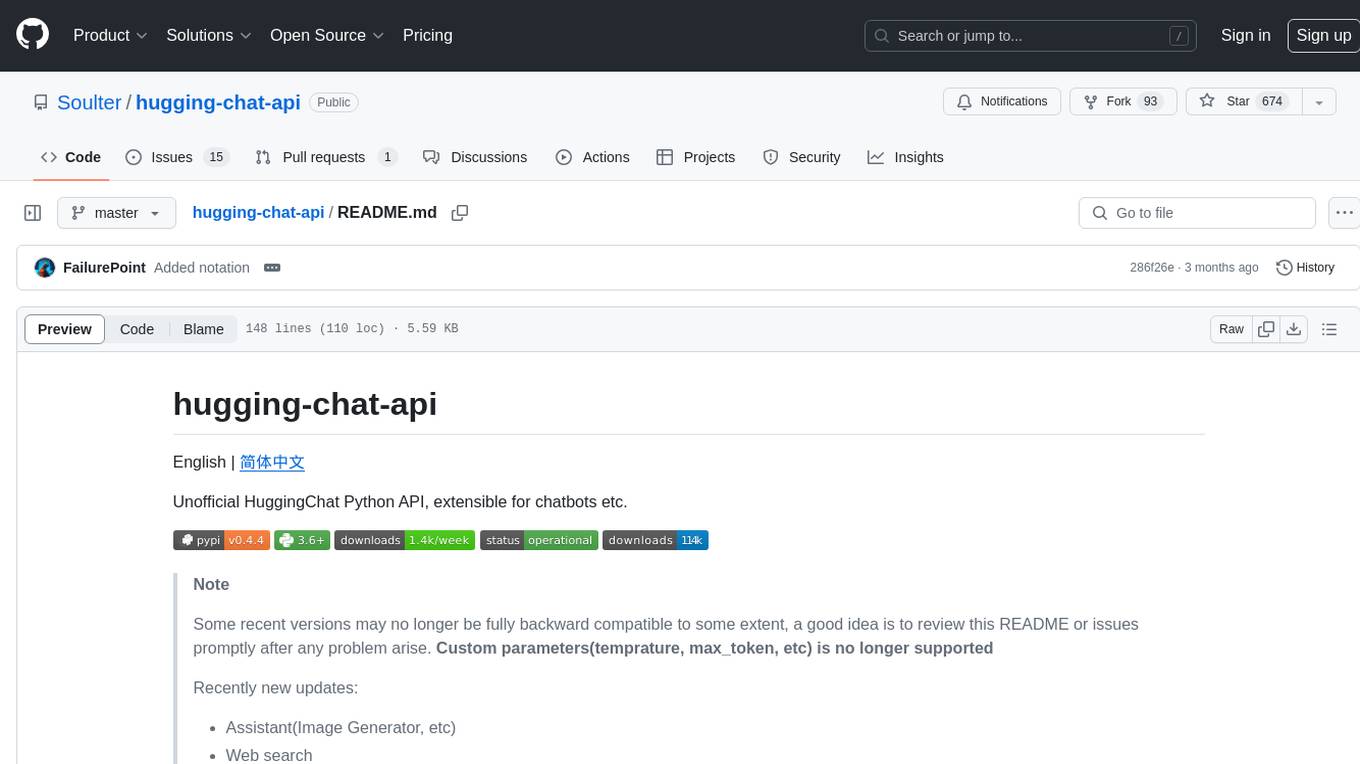
hugging-chat-api
Unofficial HuggingChat Python API for creating chatbots, supporting features like image generation, web search, memorizing context, and changing LLMs. Users can log in, chat with the ChatBot, perform web searches, create new conversations, manage conversations, switch models, get conversation info, use assistants, and delete conversations. The API also includes a CLI mode with various commands for interacting with the tool. Users are advised not to use the application for high-stakes decisions or advice and to avoid high-frequency requests to preserve server resources.
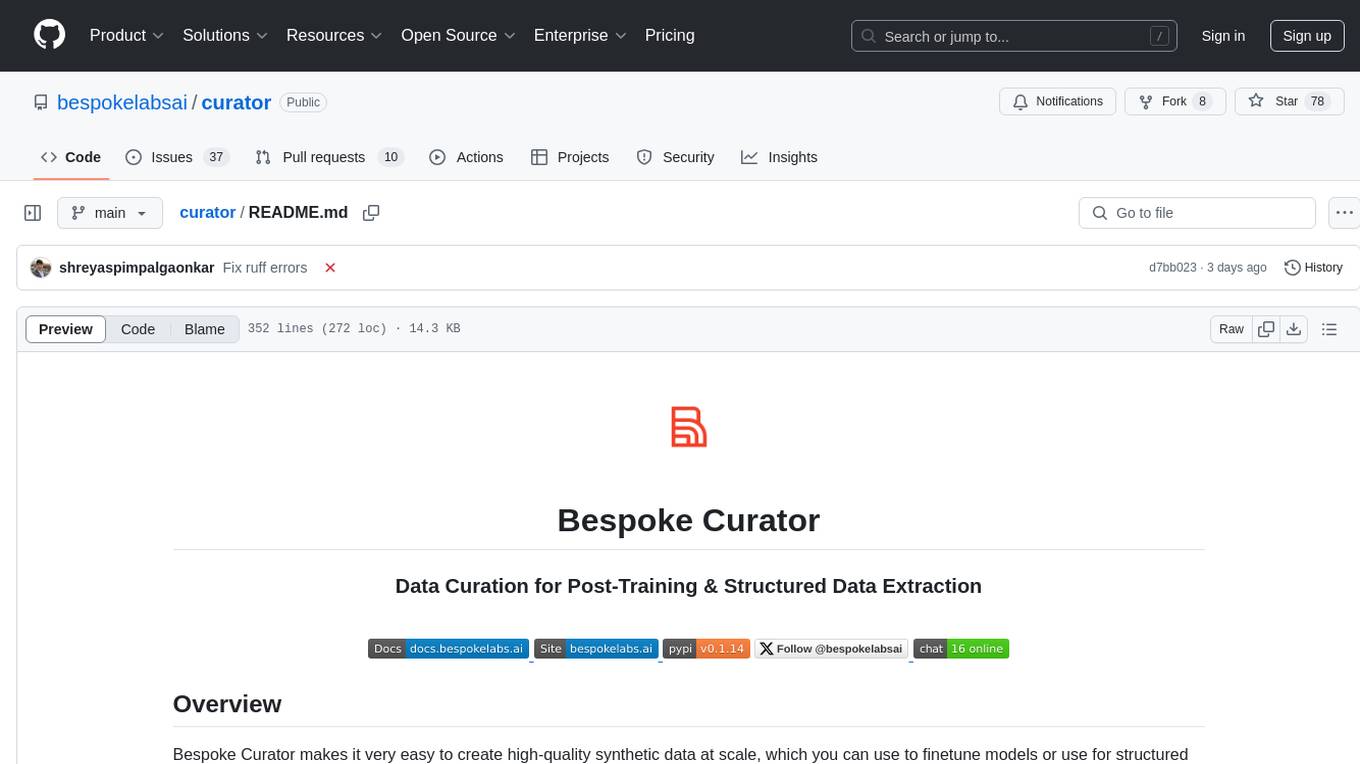
curator
Bespoke Curator is an open-source tool for data curation and structured data extraction. It provides a Python library for generating synthetic data at scale, with features like programmability, performance optimization, caching, and integration with HuggingFace Datasets. The tool includes a Curator Viewer for dataset visualization and offers a rich set of functionalities for creating and refining data generation strategies.
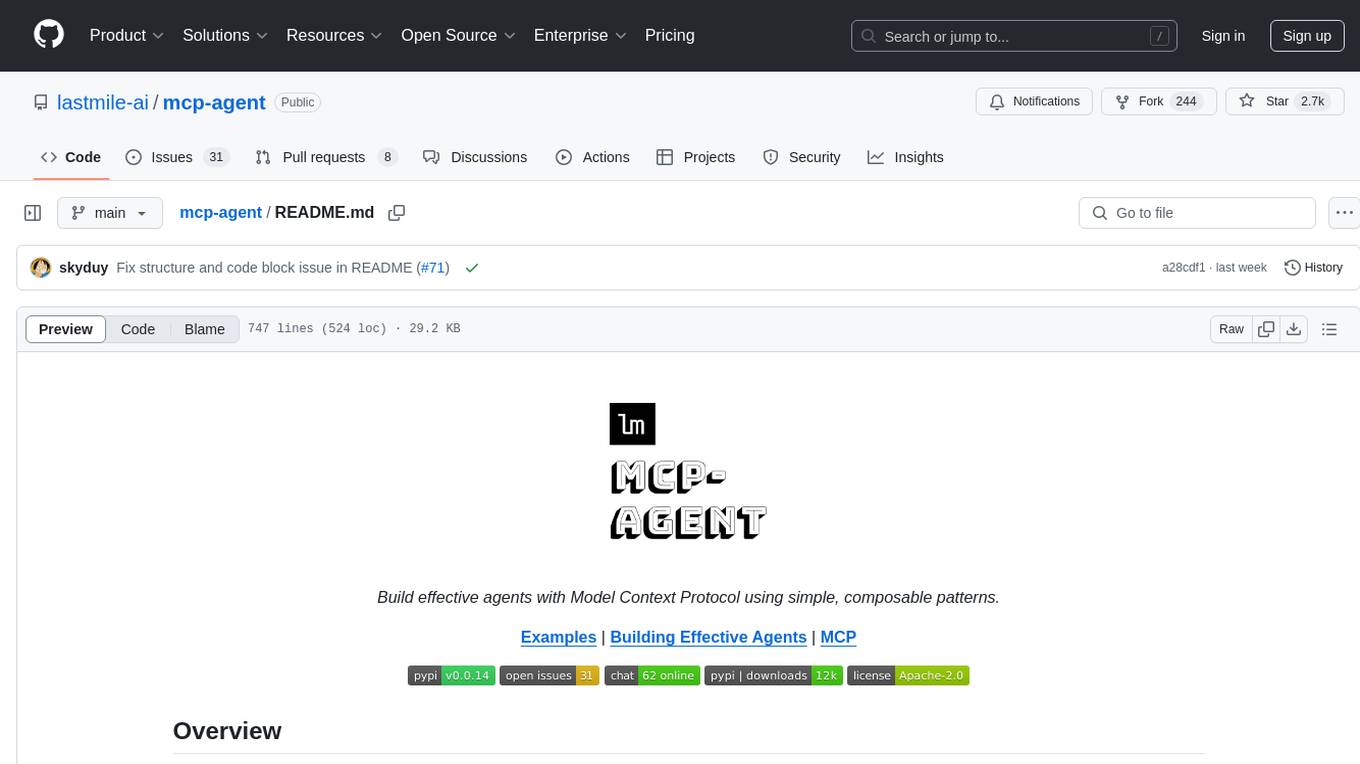
mcp-agent
mcp-agent is a simple, composable framework designed to build agents using the Model Context Protocol. It handles the lifecycle of MCP server connections and implements patterns for building production-ready AI agents in a composable way. The framework also includes OpenAI's Swarm pattern for multi-agent orchestration in a model-agnostic manner, making it the simplest way to build robust agent applications. It is purpose-built for the shared protocol MCP, lightweight, and closer to an agent pattern library than a framework. mcp-agent allows developers to focus on the core business logic of their AI applications by handling mechanics such as server connections, working with LLMs, and supporting external signals like human input.
For similar tasks

notte
Notte is a web browser designed specifically for LLM agents, providing a language-first web navigation experience without the need for DOM/HTML parsing. It transforms websites into structured, navigable maps described in natural language, enabling users to interact with the web using natural language commands. By simplifying browser complexity, Notte allows LLM policies to focus on conversational reasoning and planning, reducing token usage, costs, and latency. The tool supports various language model providers and offers a reinforcement learning style action space and controls for full navigation control.
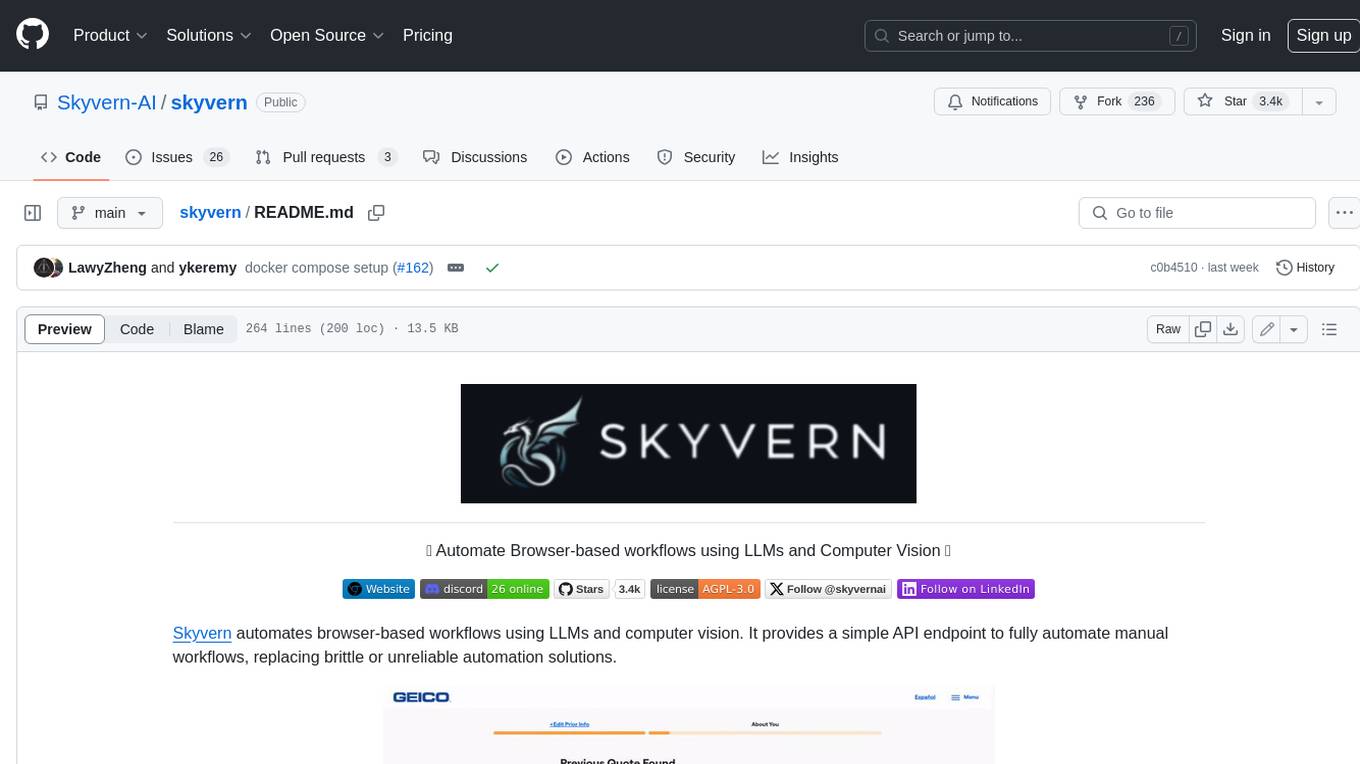
skyvern
Skyvern automates browser-based workflows using LLMs and computer vision. It provides a simple API endpoint to fully automate manual workflows, replacing brittle or unreliable automation solutions. Traditional approaches to browser automations required writing custom scripts for websites, often relying on DOM parsing and XPath-based interactions which would break whenever the website layouts changed. Instead of only relying on code-defined XPath interactions, Skyvern adds computer vision and LLMs to the mix to parse items in the viewport in real-time, create a plan for interaction and interact with them. This approach gives us a few advantages: 1. Skyvern can operate on websites it’s never seen before, as it’s able to map visual elements to actions necessary to complete a workflow, without any customized code 2. Skyvern is resistant to website layout changes, as there are no pre-determined XPaths or other selectors our system is looking for while trying to navigate 3. Skyvern leverages LLMs to reason through interactions to ensure we can cover complex situations. Examples include: 1. If you wanted to get an auto insurance quote from Geico, the answer to a common question “Were you eligible to drive at 18?” could be inferred from the driver receiving their license at age 16 2. If you were doing competitor analysis, it’s understanding that an Arnold Palmer 22 oz can at 7/11 is almost definitely the same product as a 23 oz can at Gopuff (even though the sizes are slightly different, which could be a rounding error!) Want to see examples of Skyvern in action? Jump to #real-world-examples-of- skyvern
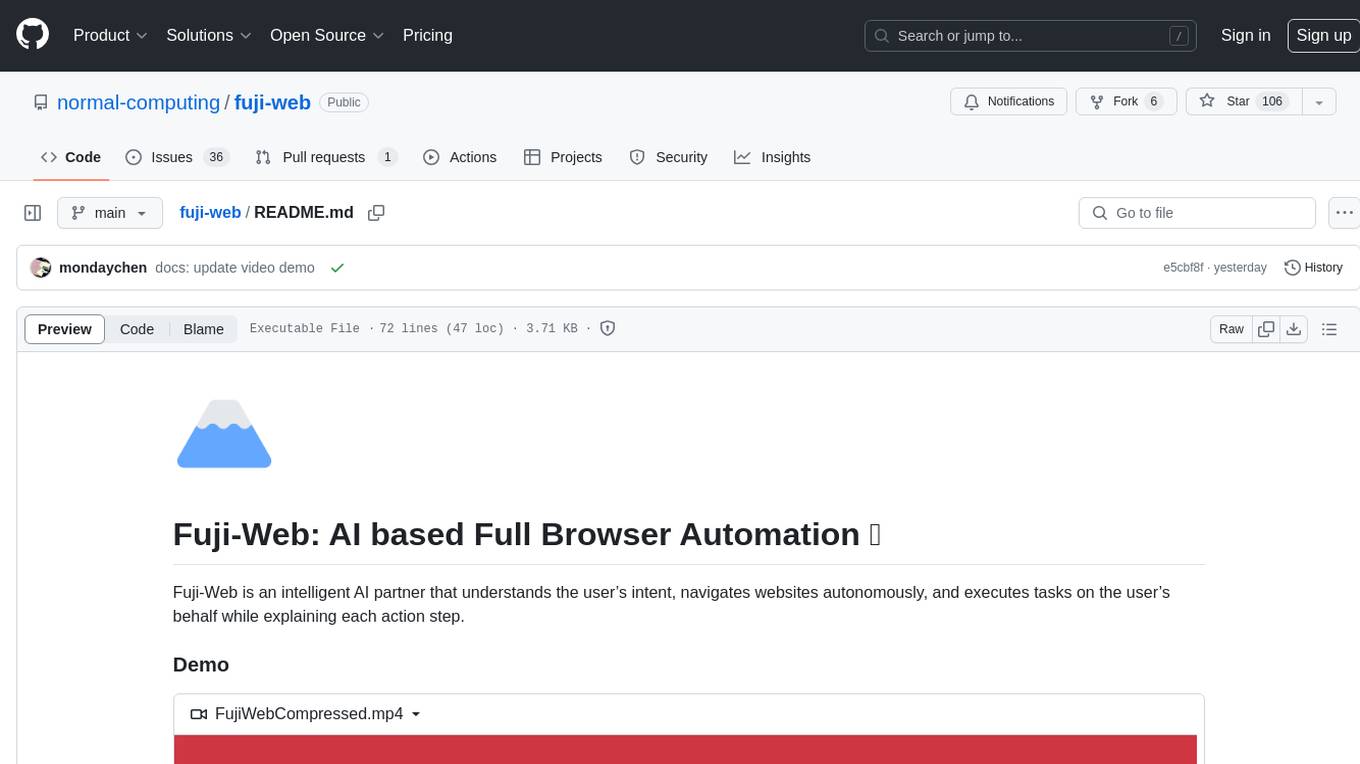
fuji-web
Fuji-Web is an intelligent AI partner designed for full browser automation. It autonomously navigates websites and performs tasks on behalf of the user while providing explanations for each action step. Users can easily install the extension in their browser, access the Fuji icon to input tasks, and interact with the tool to streamline web browsing tasks. The tool aims to enhance user productivity by automating repetitive web actions and providing a seamless browsing experience.
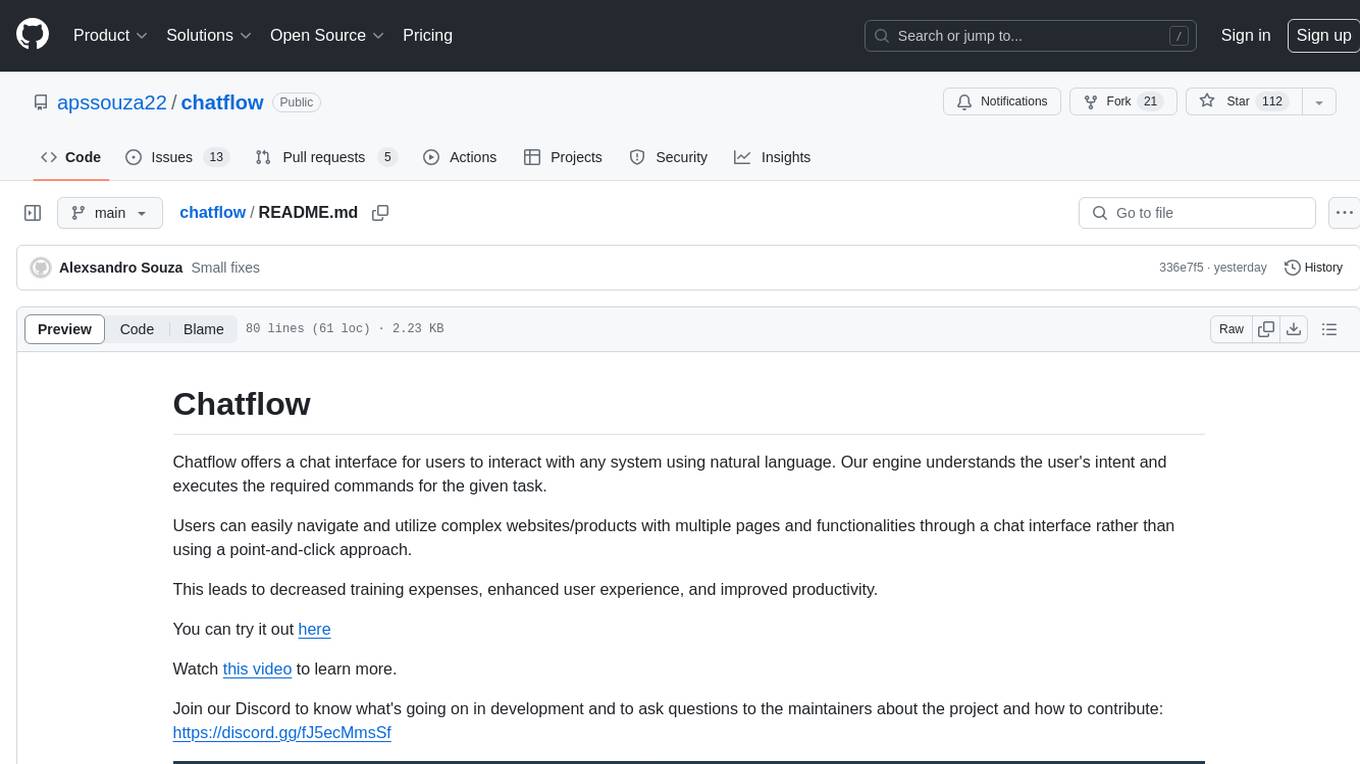
chatflow
Chatflow is a tool that provides a chat interface for users to interact with systems using natural language. The engine understands user intent and executes commands for tasks, allowing easy navigation of complex websites/products. This approach enhances user experience, reduces training costs, and boosts productivity.
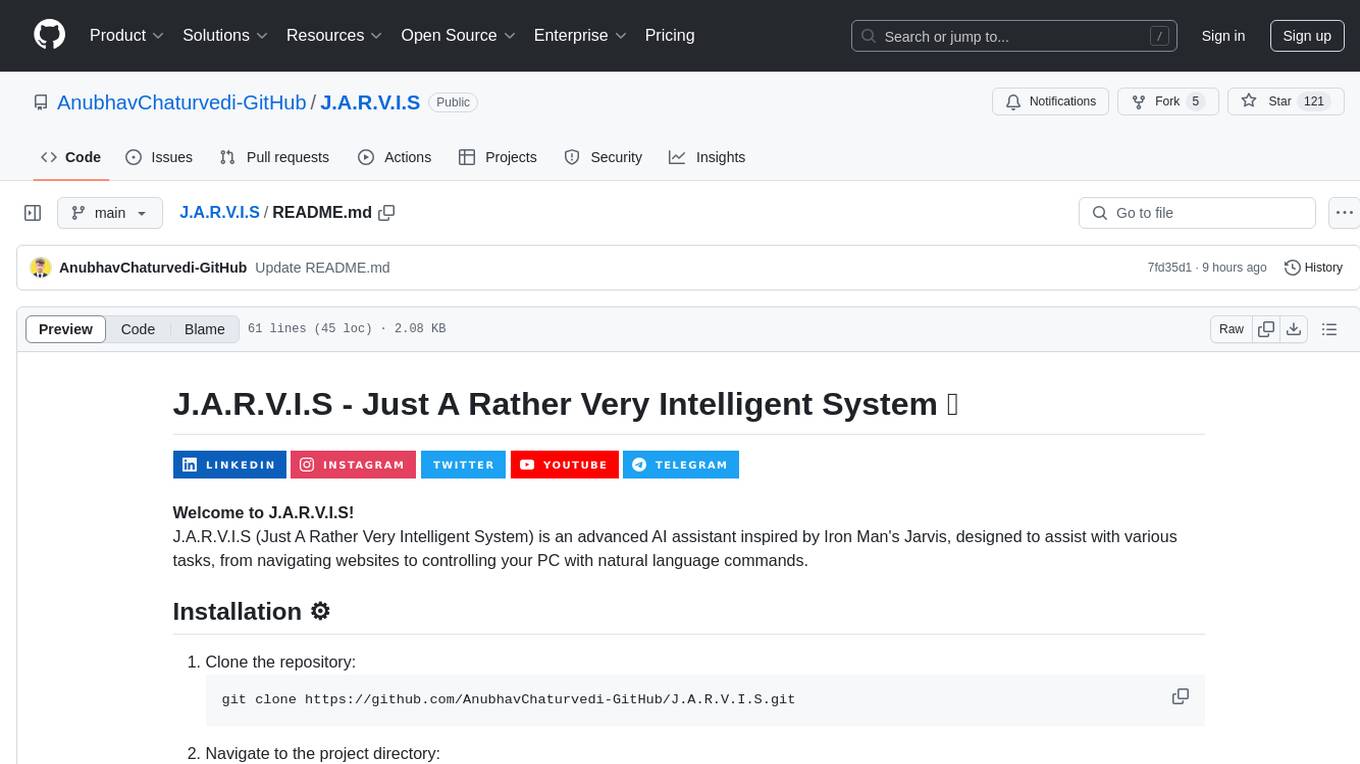
J.A.R.V.I.S
J.A.R.V.I.S (Just A Rather Very Intelligent System) is an advanced AI assistant inspired by Iron Man's Jarvis, designed to assist with various tasks, from navigating websites to controlling your PC with natural language commands.
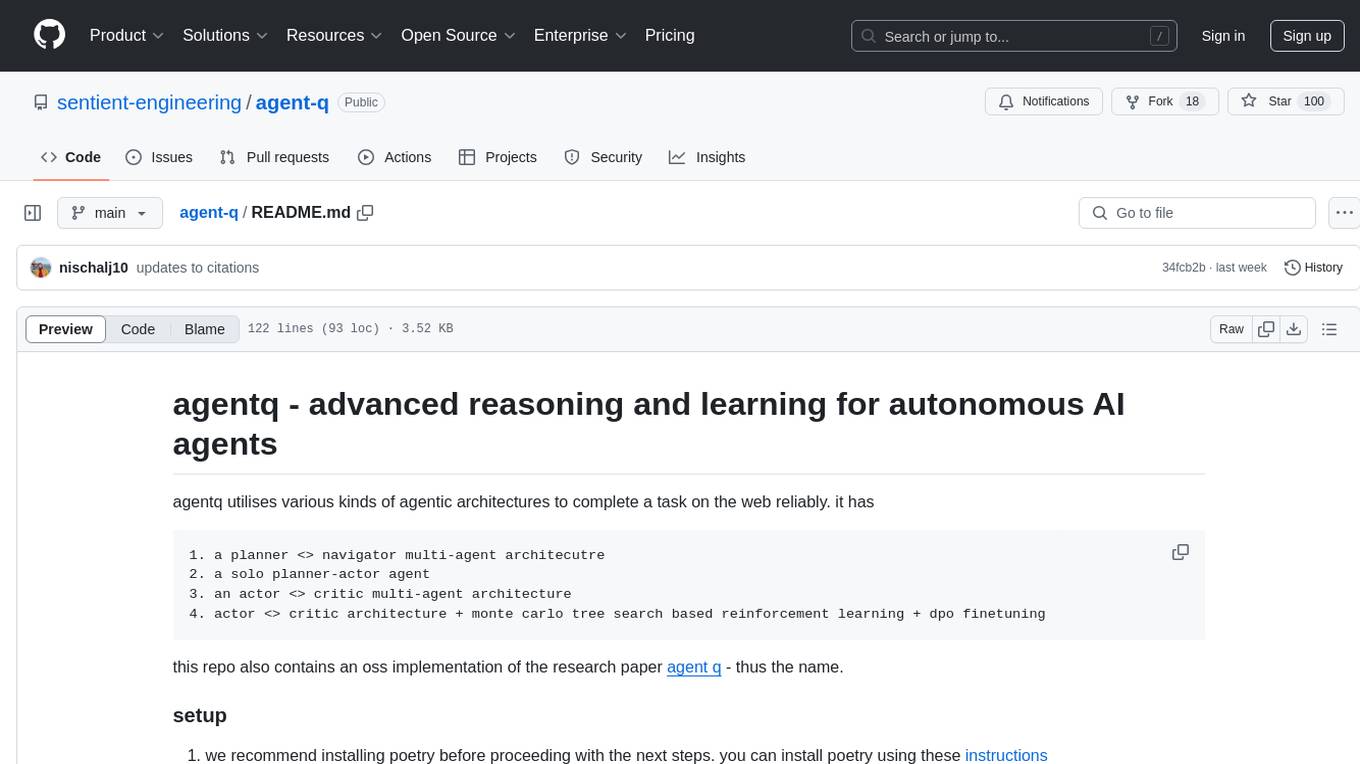
agent-q
Agentq is a tool that utilizes various agentic architectures to complete tasks on the web reliably. It includes a planner-navigator multi-agent architecture, a solo planner-actor agent, an actor-critic multi-agent architecture, and an actor-critic architecture with reinforcement learning and DPO finetuning. The repository also contains an open-source implementation of the research paper 'Agent Q'. Users can set up the tool by installing dependencies, starting Chrome in dev mode, and setting up necessary environment variables. The tool can be run to perform various tasks related to autonomous AI agents.
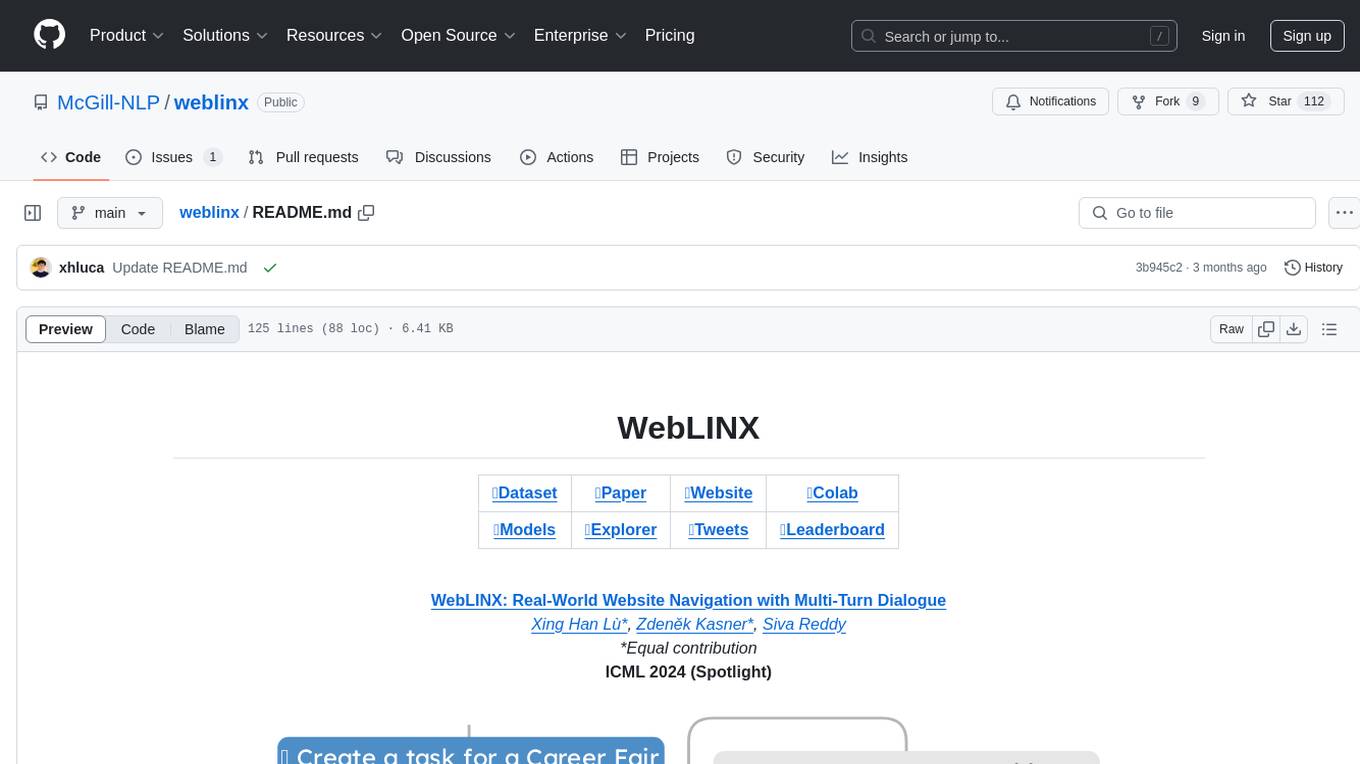
weblinx
WebLINX is a Python library and dataset for real-world website navigation with multi-turn dialogue. The repository provides code for training models reported in the WebLINX paper, along with a comprehensive API to work with the dataset. It includes modules for data processing, model evaluation, and utility functions. The modeling directory contains code for processing, training, and evaluating models such as DMR, LLaMA, MindAct, Pix2Act, and Flan-T5. Users can install specific dependencies for HTML processing, video processing, model evaluation, and library development. The evaluation module provides metrics and functions for evaluating models, with ongoing work to improve documentation and functionality.
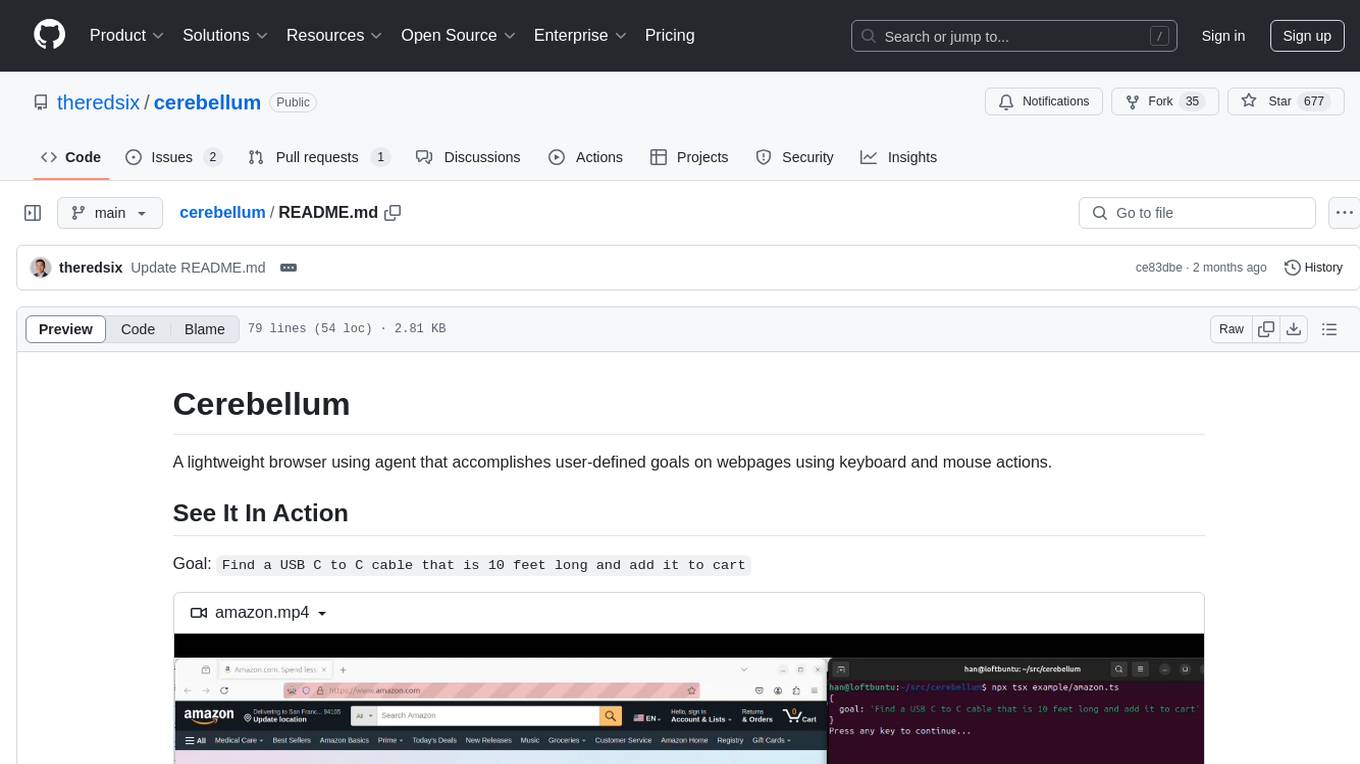
cerebellum
Cerebellum is a lightweight browser agent that helps users accomplish user-defined goals on webpages through keyboard and mouse actions. It simplifies web browsing by treating it as navigating a directed graph, with each webpage as a node and user actions as edges. The tool uses a LLM to analyze page content and interactive elements to determine the next action. It is compatible with any Selenium-supported browser and can fill forms using user-provided JSON data. Cerebellum accepts runtime instructions to adjust browsing strategies and actions dynamically.
For similar jobs

sweep
Sweep is an AI junior developer that turns bugs and feature requests into code changes. It automatically handles developer experience improvements like adding type hints and improving test coverage.

teams-ai
The Teams AI Library is a software development kit (SDK) that helps developers create bots that can interact with Teams and Microsoft 365 applications. It is built on top of the Bot Framework SDK and simplifies the process of developing bots that interact with Teams' artificial intelligence capabilities. The SDK is available for JavaScript/TypeScript, .NET, and Python.

ai-guide
This guide is dedicated to Large Language Models (LLMs) that you can run on your home computer. It assumes your PC is a lower-end, non-gaming setup.

classifai
Supercharge WordPress Content Workflows and Engagement with Artificial Intelligence. Tap into leading cloud-based services like OpenAI, Microsoft Azure AI, Google Gemini and IBM Watson to augment your WordPress-powered websites. Publish content faster while improving SEO performance and increasing audience engagement. ClassifAI integrates Artificial Intelligence and Machine Learning technologies to lighten your workload and eliminate tedious tasks, giving you more time to create original content that matters.

chatbot-ui
Chatbot UI is an open-source AI chat app that allows users to create and deploy their own AI chatbots. It is easy to use and can be customized to fit any need. Chatbot UI is perfect for businesses, developers, and anyone who wants to create a chatbot.

BricksLLM
BricksLLM is a cloud native AI gateway written in Go. Currently, it provides native support for OpenAI, Anthropic, Azure OpenAI and vLLM. BricksLLM aims to provide enterprise level infrastructure that can power any LLM production use cases. Here are some use cases for BricksLLM: * Set LLM usage limits for users on different pricing tiers * Track LLM usage on a per user and per organization basis * Block or redact requests containing PIIs * Improve LLM reliability with failovers, retries and caching * Distribute API keys with rate limits and cost limits for internal development/production use cases * Distribute API keys with rate limits and cost limits for students

uAgents
uAgents is a Python library developed by Fetch.ai that allows for the creation of autonomous AI agents. These agents can perform various tasks on a schedule or take action on various events. uAgents are easy to create and manage, and they are connected to a fast-growing network of other uAgents. They are also secure, with cryptographically secured messages and wallets.

griptape
Griptape is a modular Python framework for building AI-powered applications that securely connect to your enterprise data and APIs. It offers developers the ability to maintain control and flexibility at every step. Griptape's core components include Structures (Agents, Pipelines, and Workflows), Tasks, Tools, Memory (Conversation Memory, Task Memory, and Meta Memory), Drivers (Prompt and Embedding Drivers, Vector Store Drivers, Image Generation Drivers, Image Query Drivers, SQL Drivers, Web Scraper Drivers, and Conversation Memory Drivers), Engines (Query Engines, Extraction Engines, Summary Engines, Image Generation Engines, and Image Query Engines), and additional components (Rulesets, Loaders, Artifacts, Chunkers, and Tokenizers). Griptape enables developers to create AI-powered applications with ease and efficiency.





